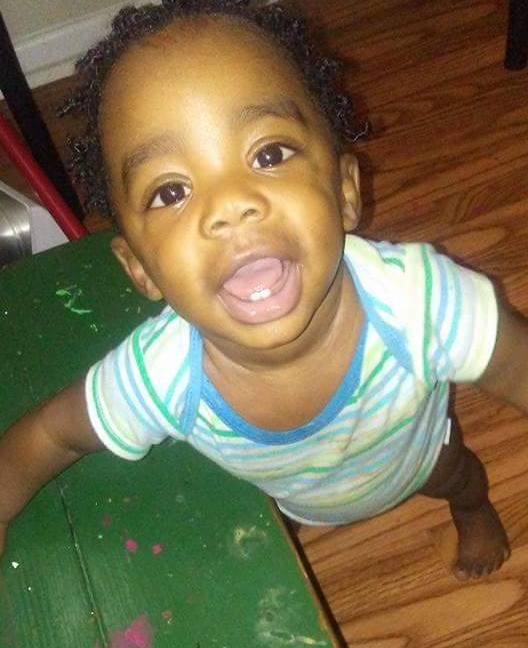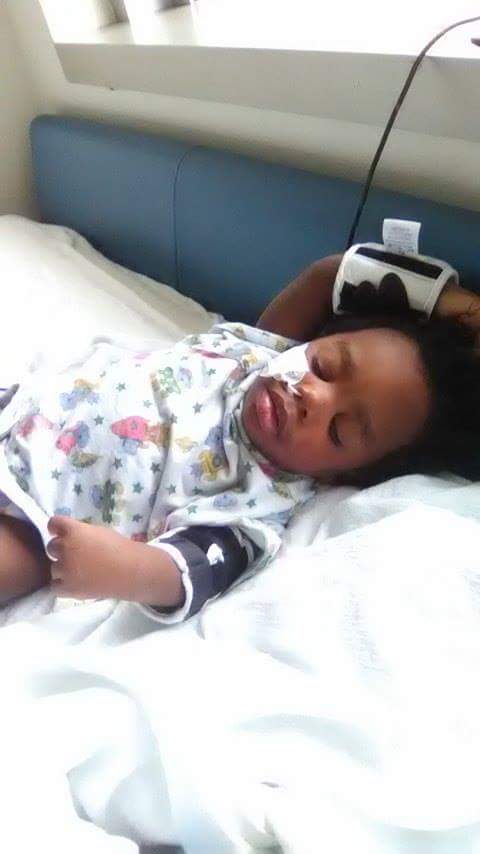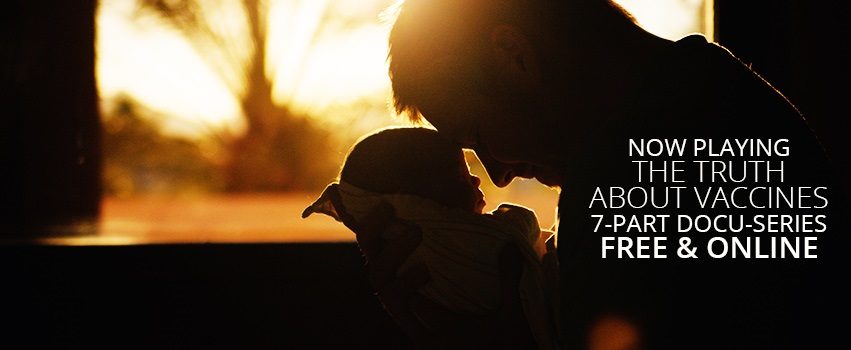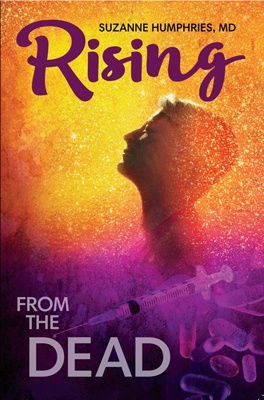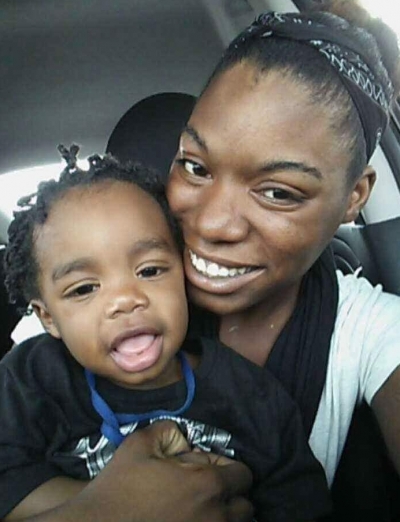
Durenda and her son KJ on his 1st birthday, before he had 8 shots in one day.
by Health Impact News/MedicalKidnap.com Staff
A young Georgia mother had no idea that a routine trip to the pediatrician’s office for her son’s 1 year check-up would change her son’s life forever, and leave her fighting the state for custody of her own son. When the nurse-practitioner told her that her son was a little behind on his shots and they would need to catch up, Durenda Whitehead didn’t question the need for the vaccines. She did, however, question the safety of giving 13 vaccines at once.
Durenda’s pediatrician assured her that it was fine:
I can give up to 20 at one time.
Durenda was unaware of a research study published in the summer 2016 edition of the Journal of American Physicians and Surgeons by Neil Z. Miller entitled, “Combining Childhood Vaccines at One Visit Is Not Safe.” In a press release, Miller wrote:
Our study showed that infants who receive several vaccines concurrently…are significantly more likely to be hospitalized or die when compared with infants who receive fewer vaccines simultaneously.
Baby’s Health Declines After 13 Vaccines in One Day
During his first year of life, little KJ had a few bouts with respiratory illness, but on January 16, 2017, he was healthy, happy, and active.
His mother followed the advice of the nurse-practitioner, consenting to 8 shots at once. Some of the shots contain multiple vaccines; thus, KJ was given a total of 13 vaccines on that day – 4 shots in each leg.
Durenda said that they told her at the pediatrician’s office to give him some Tylenol, and to “play extra hard with him when he gets home.”
Studies have linked the use of acetaminophen (Tylenol) to reduce fever after vaccinations with severe immune abnormalities that are prevalent in autism. See:
See:
Study: Evidence that Acetaminophen, Especially in Conjunction with Vaccines, is a Major Cause of Autism and Asthma
Acetaminophen (Tylenol) Harmful for Babies
Just Say No To Acetaminophen
Over the next few days, Durenda reports that KJ was sleeping much more than usual, only waking to eat. She describes his decline a couple of nights later:
I went into my kids room to pack their clothes [for my mother to babysit while I went to work]. I noticed my son didn’t attempt to follow me as usual and he started to cry. I called his name so he would come to me, but his cry only got louder. When I came back in the room to see why he wasn’t coming, he leaned his body forward and reached for me. I then said to my son, “Stop being lazy. I’m not about to pick you up.”
He leaned his body forward again and had this ‘help me’ look in his eyes while he continued to cry.

“Help me.” KJ couldn’t even sit up unsupported that day. Photo courtesy of the family.
This was not normal for him at all. Durenda says she tried to stand him up, but his legs were trembling and limp, and he kept falling down.
Alarmed, she called her mother, who told her to bring the children over. They decided that Grandma was going to watch extra closely while Durenda worked a double shift the next day. By the next evening, Durenda’s mother called her at work, concerned that KJ was “lethargic, spaced out, and slumped over when trying to sit up.”
Because KJ and his 4-year-old sister were asleep by the time that Durenda got to her mother’s house, she decided to go to the emergency room at Athens Regional Hospital first thing in the morning on January 23. (The family had recently moved to Athens from Macon, but were still going to their pediatrician’s office in Macon.)
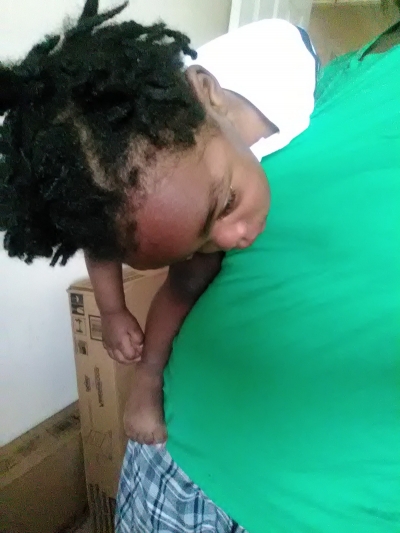
KJ couldn’t even hold his head up straight, less than a week after vaccines. Photo courtesy of the family.
Durenda explained to the E.R. staff that her chief complaint was:
He was spaced out, [and] had weakness and trembling in his legs and swelling where his shots were given…. I told the E.R. doctor that my son had received 8 shots earlier that week. He gradually lost his ability to use his legs properly and was acting very abnormal.
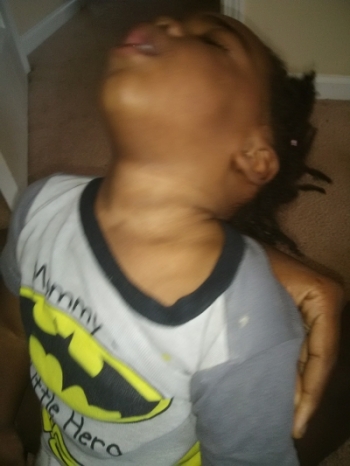
KJ after vaccines. Photo courtesy of the family.
The doctor decided to run a CT scan on the baby, then reported to Durenda that he saw “black lesions” or inflammation on her son’s brain. He told her that an MRI would give them better answers as to what was happening, but they didn’t have the equipment there to do the MRI. He set up a transfer to Children’s Health Care of Atlanta.
Within a few hours, KJ’s daddy Keynard rode with him in the ambulance to Atlanta, while Durenda and her daughter followed in her car.
Durenda says that the E.R. doctor in Atlanta “did a spinal tap and another CT scan on my son because his concern was ADEM [Acute disseminated encephalomylitis], post-vaccination encephalitis, or some metabolic issue.”
KJ was sedated the following afternoon for the MRI. Durenda left her family at the hospital to take a work excuse to her job, which was an hour away. She was almost back to the hospital, just one exit away when she was in a car accident. Her face slammed into the steering wheel, busting her lip and causing her eye to be very swollen. Even so, all she could think about was getting back to her baby, who had come out of sedation.
Police on the scene told her that her car needed to be towed and called for a tow truck and another officer to come take her to the hospital with her baby.
By the time she got to the hospital, it was close to 9 pm. KJ had been moved to a regular room. Durenda went straight to the room and climbed onto the bed to hold her son close to her. It had been a very stressful day.
Doctor Recommends PICU Based on the Wrong Diagnosis
Shortly after she arrived, a doctor came into the room to introduce herself. She told the family that KJ may need to move upstairs to the PICU (Pediatric Intensive Care Unit) because she had heard that he was admitted for breathing issues. Durenda reports that she immediately sat up a bit and said:
No, ma’am. My son is here because he has been very weak and spaced out after receiving his vaccines earlier this week and he’s been acting very abnormal.
The doctor appeared confused. Durenda explained that KJ used to have episodes of bronchiolitis for which she and his father sought medical attention, but that it had been several months since he had an issue with it. That could be what was in the records, but it wasn’t what they were currently there for. The doctor ordered a blood gas test to make sure that he was breathing adequately.
When the results came back affirming that there were no breathing issues, the doctor still insisted that KJ went to the PICU floor. She reportedly told the family that she felt it would be best because, if KJ were to begin to have breathing issues, they are not as “equipped” on that floor as the doctors in the PICU would be, and that the doctors there were waiting for him.
Durenda asked:
My son is showing no signs of respiratory issues though, so why is that such a huge concern right now?
The doctor stated that he had to go and that their daughter would not be able to go upstairs with him. Durenda says that she explained their situation – that she had been in a car accident, so they had no car in which one parent could leave with their daughter, and that it would be very difficult to find a family member that late at night who would be able to drive so far to pick her up. She says that the “doctor became hostile and stormed out of the room.”
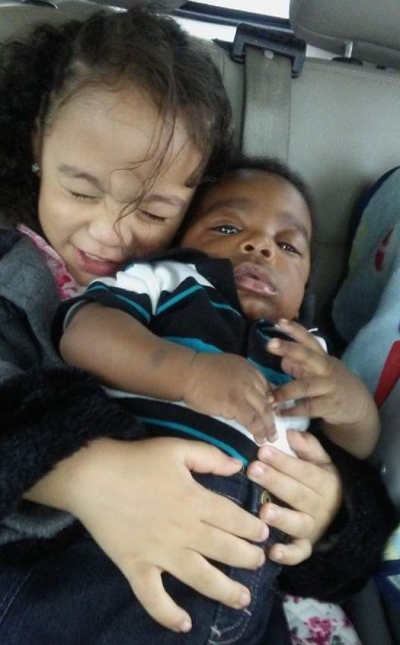
KJ is very much loved by his big sister. Photo provided by the family.
A hospital social worker showed up shortly after, and the family again explained their predicament. The social worker told them that they cannot argue with the doctor’s suggestion. They replied that they weren’t arguing with the suggestion, simply explaining their situation.
The social worker told them that he would check to see if the family room was available for Keynard and their daughter so that Durenda could accompany the baby to the PICU. They agreed to that.
Hospital Security Enforces Doctor’s Wrong Diagnosis
However, the doctor came back to the room a few minutes after the social worker left. She was flanked by 4 hospital security guards, with police officers and a state trooper standing just outside the door.
One of the guards surrounding the bed where Durenda sat holding her son told her that he heard that they were not willing “to comply with the doctor’s orders” and that they were “refusing treatment.”
Durenda explained that this was not the case and that “the doctor came in with false information about [her] son’s health condition.”
The security guard reportedly took issue with that, saying:
Oh, you think you know more than the doctor now?
Durenda said:
No, sir, but this is her first time ever seeing him. I know my son and I know the reason I brought my son to the hospital and that’s not why. Even the test she just ran proved that.
That was not good enough for the security guard, who told her:
Whatever the doctor says goes. If she says he’s going to PICU, then he’s going if that means we have to take him.
Medically Kidnapped under Terrell Peterson Act
At that point, the young mother asked to transfer to another facility to get help for her son, but they refused. The conversation escalated from there. A nurse practitioner came into the room with a paper, telling the parents that they had violated the Terrell Peterson Act.
Since Durenda had never heard of the act, she asked how they were violating it.
The nurse practitioner reportedly grabbed a piece of paper, came and stood directly in [Durenda’s] face and read aloud,
Terrell Peterson was a boy who was in imminent danger and needed special medical treatment but his parents refused and took him from the hospital and he later went home and died.
Durenda pointed out that her son was not in imminent danger, nor were they refusing treatment.
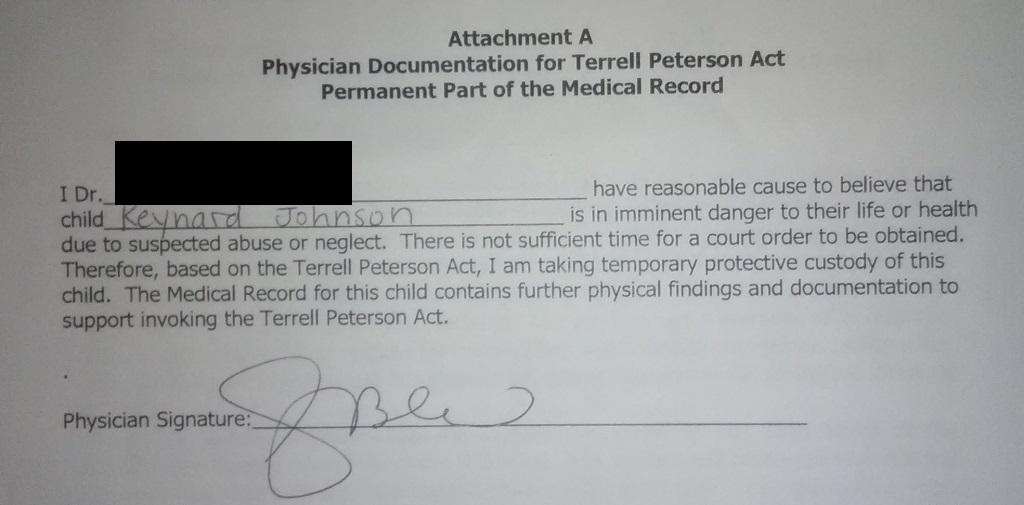
The Terrell Peterson Act was passed by the Georgia legislature in 2000 after a little boy did, indeed, die eventually after he was taken home from the hospital and denied medical treatment.
However, it was not the parents who abused him or denied him treatment. It was, in fact, his foster mother who was responsible for his death – a foster mother chosen by the Department of Family and Children Services (DFACS). According to an investigative report by 60 Minutes, the little boy had been viciously abused in foster care, and DFACS failed to follow many of their own protocols to protect Terrell Peterson, as well hundreds of other children who were placed in their care.
Nonetheless, the doctor had already signed the document, and the conflict between Durenda and the hospital staff ended with security physically taking KJ out of Durenda’s arms and kicking the rest of the family out of the hospital, literally out into the street.
Child Protective Services was called into the situation and found KJ “dependent,” based on the reports from the hospital that the child had respiratory issues and that the family did not agree with the doctors that he needed treatment in the PICU.
The reports accused the parents of trying to take KJ out of the hospital. Durenda wonders if that part referred to her request that he be transferred to another hospital, something that should be the right of any parent. There was no way that they could have whisked him away from the hospital even if they wanted to because her car was wrecked.
KJ’s parents were not permitted to see or visit him at all until after the 72-hour hearing.
The family scraped together money to hire an attorney, who reportedly advised them to waive the initial hearing.
Baby Gets Sicker in Hospital but Moved Out of PICU
Though the test results show that there were no signs of breathing problems on the day that the hospital seized custody of KJ and transferred him to the PICU, he caught a viral infection on the ward, causing his bronchiolitis to flare up. By the time his parents were able to visit him after the 72-hour hearing, KJ had been placed on a ventilator. He lost the ability to move and was still unable to hold up his head. According to Durenda:
My son looked ten times worse than he did when the hospital took him from me.
Despite this, the PICU staff had KJ moved back down to the first floor, the floor where he was taken from his parents. The PICU reportedly told Durenda that he was not “PICU criteria,” even though he actually had developed breathing problems requiring a ventilator by this point.
Medical reports show that KJ did not test positive for any respiratory problems until after he was taken from his parents, who were faulted for insisting that he was not having respiratory problems.
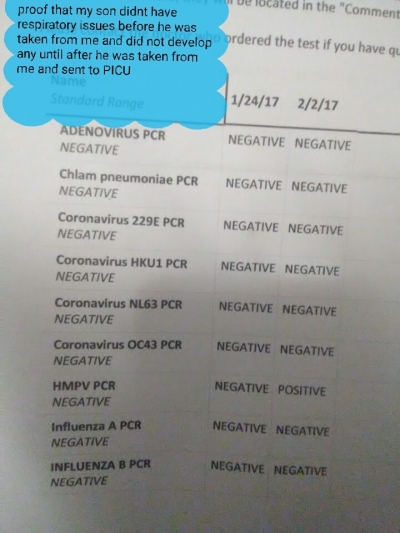
Durenda says that it was quite obvious to her that the numerous vaccines in one day were what precipitated her son’s condition, but most medical personnel appear to be in denial about that possibility. One of the primary theories at the beginning was that KJ had some kind of metabolic issue causing his symptoms. However, over the next two weeks after he was taken, multiple tests were run and all the metabolic panels came back normal.
When that happened, Durenda asked if they had figured out what caused the inflammation in KJ’s brain. She was reportedly told:
We aren’t focusing on a diagnosis; we’re just going to try to start his therapy to help him get better.
At that point, Durenda realized that it would be difficult to get any doctor to look closely at the real source of his condition – the vaccines.
Doctors transferred KJ to in-patient rehabilitation and started KJ on a regimen of occupational, physical, and speech therapy. It was with the rehab staff that Durenda found support for her family.
They told the DFACS investigator that it was their recommendation that KJ’s parents remain at the hospital with no limitations on visitation:
because that seemed to be the only time my son could stay calm enough to receive the physical, occupational, and speech therapy he needs because he was less irritable when we were around to comfort him.




